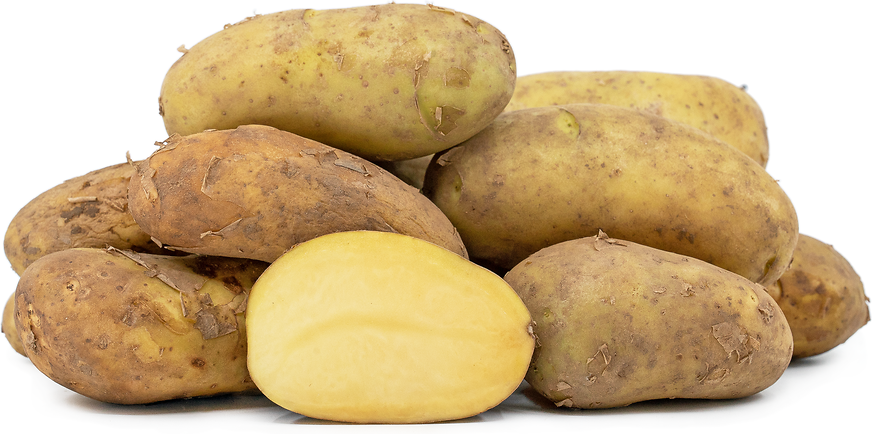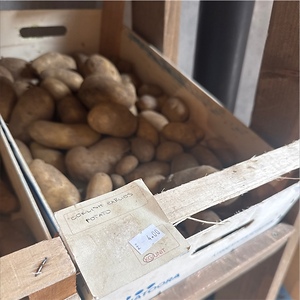


Early Cornish Potatoes
Estimated Inventory, lb : 0
Description/Taste
Early Cornish potatoes are a small to medium-sized varietal, averaging 5 to 6 centimeters in diameter and 7 to 10 centimeters in length, and have an elongated, oval appearance. The ends of each tuber are blunt and curved, and the tubers are typically straight, sometimes showcasing a slight bend in the center. The potato's skin is very thin, flaky, and delicate, easily scratched off or damaged. The golden yellow to light brown skin is also semi-smooth, firm, and taut, with a few medium-set eyes. Underneath the surface, the golden yellow flesh is dense, slippery, and fine-grained. When cooked, Early Cornish potatoes develop a creamy, tender, and buttery consistency. One of the unique elements of Early Cornish potatoes is the flesh's sugar content. Since the tubers are harvested young, the flesh has not converted the natural sugars into starches, giving the potatoes a fresh, mild, sweet, and earthy flavor.
Seasons/Availability
Early Cornish potatoes are available in the early summer, typically from mid-May to the beginning of August.
Current Facts
Early Cornish potatoes, botanically classified as Solanum tuberosum, is a general descriptor used to encompass several varieties of early-season potatoes belonging to the Solanaceae or nightshade family. The name Early Cornish is used for any type of new season potato cultivated in Cornwall, England. Popular varieties include Jazzy, Maris Peer, Lady Christl, Rocket, and Gemson. Early Cornish potatoes are the first potatoes to arrive in English markets each season and are tubers that have been harvested by hand when they are young to maintain tender skin and flesh. The potatoes are only available for a few months each year, and most of the farmers who grow the tubers are descendants of families that have been multi-generational potato growers. Early Cornish potatoes are also known as Cornish Earlies and Cornish New potatoes and are an anticipated seasonal delicacy favored among British consumers for their mild, sweet flavor. The variety is typically sold "dirty," meaning the tubers are sold with patches of soil still attached to the surface, a method to preserve the flavor and protect the surface from damage. Early Cornish potatoes are a versatile variety only available in limited quantities and used in various culinary preparations.
Nutritional Value
Early Cornish potatoes are a source of potassium to balance fluid levels within the body and fiber to regulate the digestive tract. The tubers also provide vitamin C to strengthen the immune system, copper to produce red blood cells, and other nutrients, including folate, phosphorus, magnesium, iron, and vitamin B6.
Applications
Early Cornish potatoes have a mild, sweet, and subtly earthy flavor suited for cooked preparations. Potatoes cannot be consumed raw and should be washed and cleaned before use. Early Cornish potatoes have thin skin that can be flaked off using a fingernail or easily peeled once cooked. The potatoes also hold their shape well, allowing them to be boiled or steamed and tossed into hot or cold salads. Early Cornish potatoes can also be baked or roasted whole, served with meat in main dishes, or paired with vegetables as a flavorful side. The variety does not need to be peeled and can add texture and flavoring to pot roasts, curries, casseroles, and soup. Try roasting Early Cornish potatoes and sprinkling salt, herbs, and light oil to create a savory accompaniment or baking the potatoes into a pot pie. Early Cornish potatoes pair well with spices such as paprika, cumin, turmeric, lemon, cheeses including halloumi, parmesan, brie, and blue, and herbs such as fennel, oregano, mint, thyme, and rosemary. Whole, unwashed Early Cornish potatoes will keep for a few weeks when stored in a cool, dry, and dark place away from direct sunlight.
Ethnic/Cultural Info
Cornish potatoes are a staple ingredient in the famous Cornish pasty, a flaky, pastry-like pocket filled with an array of sweet and savory ingredients. The origins of Cornish pasties can be traced back as far as the 13th century and were initially a dish reserved for the upper class in England. The pockets were filled with meats, rich gravies, root vegetables, or sweet fruits to create a filling dish, and even in one pasty, the pocket could be filled with half sweet ingredients and half savory. Later in the 17th and 18th centuries, pasties were made by the wives of tin miners, expanding the dish to the working class. The pasties were traditionally divided and made with one sweet and one savory filling to create a complete meal, as the tin miners would have to eat their meal in the mines and needed an easy-to-eat dish. The pastries were also designed with a crimped edge on one side so working miners could quickly eat the pasty with one hand and discard the touched portion of the crust. Historically, a miner's hands would be covered in arsenic from their job, a toxic and lethal poison. The crimped crust allowed the miners to touch a part of the pasty that would not be consumed, preventing accidental poisoning. The crusts were discarded in the minds and were believed to feed the sprite-like spirits or "knockers" that dwelled in the mines. Some miners would have their wives place their initials on the crust so when they offered their crusts to the "knockers," the spirits would know which miner had been kind to them. The initials also acted as a form of labeling in case the miner decided to save half of it for later in the day. Consuming pasties was so common in tin mines that some mines had stoves specifically designed to warm the pasties for lunchtime. Over time, pasties expanded beyond mining families and became a popular on-the-go breakfast or lunch item. Pasties transformed into a staple item sold in bakeries across England, and the most popular version in the present day is filled with onions, potatoes, steak, and swede. Despite their popularity, only pasties made in Cornwall have earned a PGI or a Protected Geographical Indication. This label recognizes the traditional recipes, history, and significance of Cornish pasties and seeks to help preserve the dish.
Geography/History
Early Cornish potatoes are native to Cornwall, England, and were extensively cultivated by the mid-18th century. Cornwall is a county in southwestern England that stretches across rugged land comprised of rocky cliffs, beaches, and sloping hillsides. The county is notorious for having only a small amount of available land suited for agriculture, and the potatoes are traditionally seen planted on the sloping ground near the sea. In the entire county, no spot is more than twenty miles from the coastline, providing a milder climate for farmers during the winter. This coastal sea breeze keeps the ground from freezing and the temperatures more controlled to produce an even crop. When potatoes were first cultivated in Cornwall, the plants were seen as a staple crop, sustaining a rapidly growing population. Potatoes and pilchards were the main items consumed among the working class in Cornwall, and with extensive cultivation, many new types of potatoes were developed to meet seasonal demands. Early Cornish potatoes reached the height of their popularity at the beginning of the 19th century as growers discovered the seeds could be sown as early as January. The early-season potatoes bore a distinctly sweet flavor and delicate texture, becoming a seasonal delicacy shipped across the United Kingdom. Today Early Cornish potatoes are the first mainland potatoes to arrive in British markets and are a seasonally acclaimed potato sold fresh in local markets, grocers, and through distributors. The Early Cornish potatoes featured in the photograph above were sourced from Natoora through the Eataly Market in London, England.








